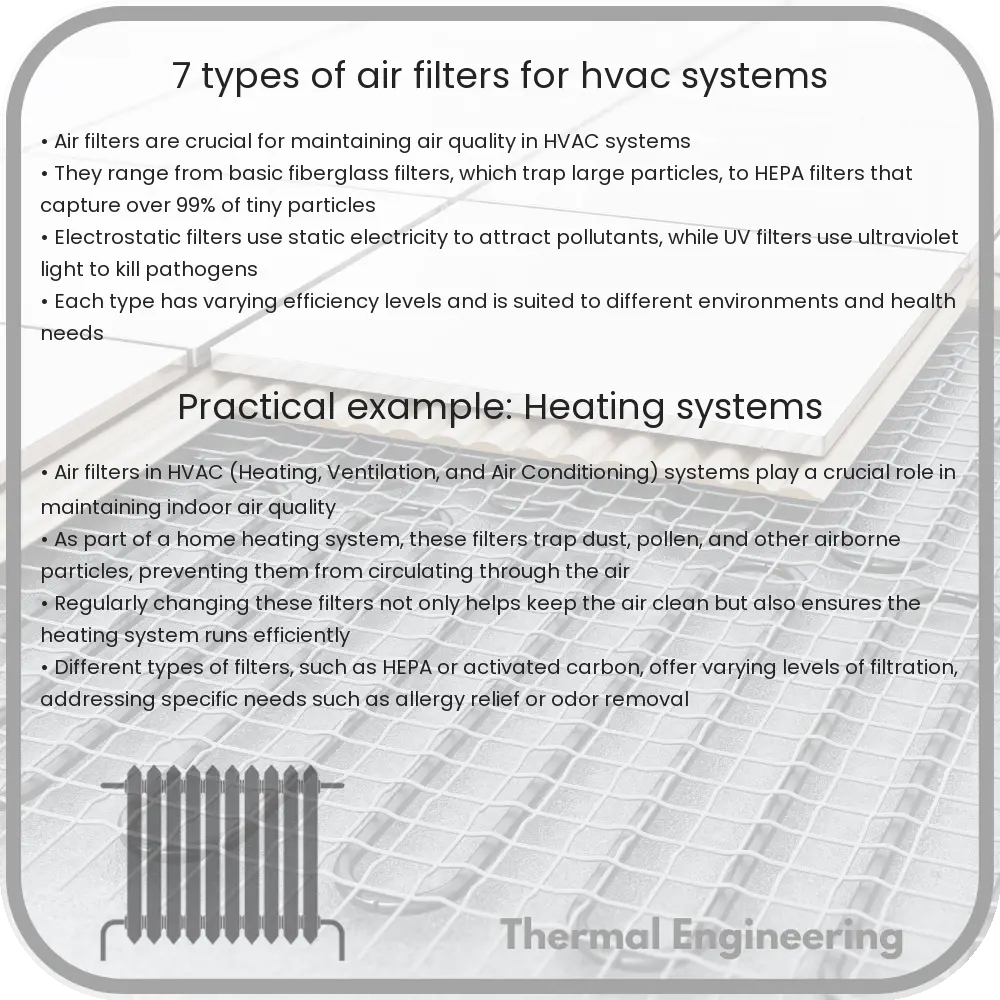Learn about seven common air filter types for HVAC systems, including fiberglass, pleated, and HEPA filters.

7 Types of Air Filters for HVAC Systems
Air filters are integral components of Heating, Ventilation, and Air Conditioning (HVAC) systems, designed to improve indoor air quality by removing pollutants and particulates. Various types of air filters are engineered to fit different needs based on efficiency, cost, and filter capabilities. Here’s a look at seven common types of air filters used in HVAC systems.
Fiberglass Air Filters
Fiberglass air filters are among the most common and economical options. These filters are constructed from a flat, disposable panel of fiberglass fibers laid over each other to trap particles. Typically, fiberglass filters are designed to protect HVAC units rather than improving indoor air quality significantly, as they generally trap large dust particles and prevent them from clogging the HVAC system.
Pleated Media Filters
Made from polyester fabrics or cotton folds, pleated media filters offer a greater surface area to capture airborne particles. The pleats increase the efficiency in capturing particles such as pollen, mold spores, and pet dander. These filters balance cost and performance, making them popular among residential users who seek better air filtration without a significant increase in cost.
Electrostatic Filters
Electrostatic filters use self-charging fibers to attract particulates. These filters are effective in capturing small particles and are available in both disposable and reusable forms. The reusable electrostatic filters can be washed and reinserted. They are particularly useful for homes with pets or in high dust areas, as they can capture finer particles more effectively than fiberglass or basic pleated options.
HEPA Filters
High-Efficiency Particulate Air (HEPA) filters offer the highest level of air purification among common residential HVAC filters. They can trap at least 99.97% of particles that are 0.3 microns in diameter, including tobacco smoke, dust mites, and pollen. HEPA filters are typically used in hospitals and laboratories, where air quality requirements are stringent, but they are also increasingly used in residential settings for allergy and asthma sufferers.
Activated Carbon Filters
While not typically used for particulate removal, activated carbon filters excel in removing odors and volatile organic compounds (VOCs) from the air. These filters use a bed of activated carbon to chemically absorb pollutants as air passes through. They are commonly used in settings where odor control is a priority, such as in kitchens and pet areas.
UV Filters
UV filters use ultraviolet light to kill viruses, bacteria, and mold that may pass through the HVAC system. These filters are not effective against non-living pollutants or particulates, but they are excellent for improving the sanitary quality of the indoor air. UV filters are often used in conjunction with other filtering technologies to ensure comprehensive air purification.
Washable Air Filters
Washable or reusable air filters provide a long-term cost-effective solution for air filtration. Made typically from aluminum or plastic fibers, these filters can be removed, cleaned, and re-inserted into the HVAC system. While they require more maintenance, their durability and reusability make them suitable for those looking to minimize waste and ongoing costs.
Choosing the right air filter for your HVAC system depends on a variety of factors including the specific needs of your indoor environment, maintenance capabilities, and budget. Each type of filter brings its own benefits and limitations, hence understanding these will guide you in making an informed decision to ensure optimal air quality in your space.